Chris Peters
Christiaan Anthonius Maria "Chris" Peters (born March 8, 1949 in Hillegom ) is a Dutch mathematician who deals with algebraic geometry .
Peters received his PhD in 1974 from the University of Leiden under Antonius van de Ven ( The local Torelli theorem of some cyclic branched coverings ). He was an assistant in Leiden since 1969. He was a post-graduate student at Harvard University . In 1975 he became assistant professor and in 1979 professor at the University of Leiden. Since 1994 he has been a professor at the University of Grenoble I.
In 1978 he was at the Institute for Advanced Study and visiting professor at the University of Nancy (1973), in Salt Lake City (1983), at the University of California, Los Angeles (1992) and at the Tata Institute of Fundamental Research (1992).
Fonts
- with Klaus Hulek, Miles Reid , Fabrizio Catanese (eds.): New Trends in Algebraic Geometry. Cambridge University Press, 1999.
- with José Bertin, Jean-Pierre Demailly , Luc Illusie : Introduction to Hodge Theory. SMF / AMS, 2002 (first in French in the series Panoramas et synthèses of the SMF 1996).
- with Wolf Barth , Klaus Hulek : Compact complex surfaces. 2nd Edition. Springer, 2003.
- with James Carleson, Stefan Müller-Stach : Period mappings and period domains. Cambridge University Press, 2003.
- with Müller-Stach (Ed.): Transcendental Aspects of Algebraic Cycles. (= Proceedings of the Grenoble Summer School. 2001). Cambridge University Press 2004 (therein by Peters with Siegmund Kosarew: Introduction to Lawson Homology ).
- with Jan Nagel (Ed.): Algebraic Cycles and Motives. London Mathematical Society Lecture Notes, Cambridge University Press 2007.
- with Joseph Steenbrink : Mixed Hodge Structures (= results of mathematics and their border areas. ) Springer, 2008.
- Tata Lectures on motivic aspects of Hodge theory. Narosa Publ./AMS, 2010.
- with Jan Nagel, Jacob Murre : Lectures on the theory of pure motives. American Mathematical Society, 2013.
Web links
Individual evidence
| personal data | |
|---|---|
| SURNAME | Peters, Chris |
| ALTERNATIVE NAMES | Peters, Christiaan Anthonius Maria (full name) |
| BRIEF DESCRIPTION | Dutch mathematician |
| DATE OF BIRTH | March 8, 1949 |
| PLACE OF BIRTH | Hillegom |
